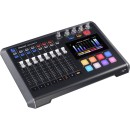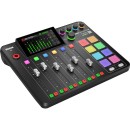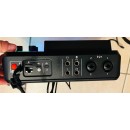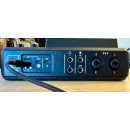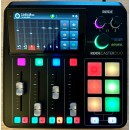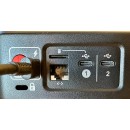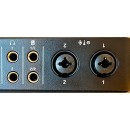TASCAM Mixcast 4 vs RODE RODECaster Pro II: Which is the Best Podcast Mixer for You?
The TASCAM Mixcast 4 Podcast Mixer and Audio Interface is a versatile tool designed for podcasters, offering a range of features to streamline audio production. It comes with four mic inputs, each with its own independent gain control and phantom power, making it ideal for multi-person podcasts. The Mixcast 4 also includes four headphone outputs with individual volume controls, ensuring that each participant can monitor the audio at their preferred level. One of its standout features is the integrated sound pads, which can be customized with various sound effects or jingles, adding a professional touch to any podcast. Additionally, it supports multitrack recording, allowing you to edit each audio track separately in post-production.
The RODE RODECaster Pro II Integrated Audio Production Studio is a comprehensive solution for podcasters and content creators. It features eight programmable sound pads, giving users the flexibility to trigger sound effects, music, or voice samples during a recording session. This mixer also boasts four high-quality mic inputs with Class A preamps, ensuring superior audio clarity. The RODECaster Pro II has advanced features such as built-in audio processing, including compression, EQ, and de-essing, which help to enhance the overall sound quality. It's designed with a user-friendly touchscreen interface, making it easy to navigate through various settings and adjustments quickly.
When comparing the two, the TASCAM Mixcast 4 is noted for its user-friendly design and essential podcasting features, making it a solid choice for beginners and intermediate users. It offers a good balance of functionality and ease of use, with the added benefit of sound pads for a more dynamic podcasting experience. The multitrack recording capability is a significant advantage for those who want more control during post-production.
On the other hand, the RODE RODECaster Pro II stands out for its professional-grade audio quality and advanced processing features. The Class A preamps and built-in audio processing tools provide a higher level of sound enhancement, which is crucial for professional podcasters and content creators who demand the best audio fidelity. The intuitive touchscreen interface also adds to its appeal, allowing for quick and efficient adjustments during live recordings.
In summary, both the TASCAM Mixcast 4 and the RODE RODECaster Pro II offer robust solutions for podcast production, but they cater to slightly different needs. The TASCAM Mixcast 4 is ideal for those looking for straightforward, effective podcasting tools with the added benefit of multitrack recording. In contrast, the RODE RODECaster Pro II is geared towards users who prioritize premium audio quality and advanced processing capabilities, making it a preferred choice for professional-grade productions.
In this article, we will thoroughly compare the TASCAM Mixcast 4 Podcast Mixer and Audio Interface with the RODE RODECaster Pro II Integrated Audio Production Studio. We'll delve deep into their specifications and review their advantages and disadvantages, providing you with all the information you need to make an informed decision on which podcast mixer is the best fit for your needs.
Specifications, Advantages, and Disadvantages
| User Rating Based on Analysis of Reviews | |
|---|---|
|
Show More |
| Pros: | |
|---|---|
|
|
| Cons: | |
|---|---|
|
|
| Find Best Price | Find Best Price |
| Key Specs | |
|---|---|
| Channels of I/O | |
| USB: 14 Inputs / 2 Outputs |
Analog: 4 Inputs / 4 Outputs |
| Built-In DSP | |
| Yes | Yes |
| Maximum Sampling Rate | |
| 48 kHz / 24-Bit | 48 kHz / 24-Bit |
| Number of Microphone Inputs | |
| 4 | 4 Preamps |
| Input Level Adjustment | |
| 8x Fader | 6x Fader |
| Number of Headphone Mixes | |
| 4x Guest | 4x Assignable with Mix-Minus |
| Analog Audio I/O | |
| 4x Combo XLR-1/4" TRS Balanced Mic Input 2x 1/4" TRS Balanced Line Input 1x 1/8" / 3.5 mm TRRS Unbalanced Line/Smartphone Input 1x 1/8" / 3.5 mm TRRS Unbalanced Headphone Output 4x 1/4" TRS Unbalanced Headphone Output 2x 1/4" TRS Balanced Monitor Output 1x 1/8" / 3.5 mm TRS Unbalanced Line Output |
4x Combo XLR-1/4" TRS Balanced/Unbalanced Mic/Line/Hi-Z Input 2x 1/4" TRS Balanced Line Output 4x 1/4" TRS Unbalanced Headphone Output |
| Host Connection | |
| 1x USB-C (Class-Compliant) | 2x USB-C |
| OS Compatibility | |
| 10 or Later 13 or Later iPadOS 13 or Later macOS 10.15 macOS 11 macOS 12 Windows 10 macOS 11 |
macOS 10.15 or Later Windows 10.1803 or Later Windows 11 iPadOS |
| Power Requirements | |
| AC/DC Power Adapter (Included) | AC/DC Power Adapter (Included) or USB Bus Power |
The TASCAM Mixcast 4 Podcast Mixer and Audio Interface offers a versatile input/output configuration with 14 USB inputs and 2 outputs. It features 4 microphone inputs with an adjustable input level provided by 8 faders. The mixer also supports a maximum sampling rate of 48 kHz / 24-Bit and includes built-in DSP for enhanced audio processing. For headphone monitoring, it provides 4 guest headphone mixes and various analog audio I/O options, including 4 combo XLR-1/4" TRS balanced mic inputs and a 1/8" / 3.5 mm TRRS unbalanced headphone output.Show More
On the other hand, the
When it comes to connectivity, the TASCAM Mixcast 4 utilizes a single USB-C connection, while the RODECaster Pro II includes 2 USB-C ports for more flexible connections. Both devices are compatible with various operating systems, including macOS and Windows, but the RODECaster Pro II has a slightly broader OS compatibility, supporting Windows versions starting from 10.1803 or later. Both products require an AC/DC power adapter, but the RODECaster also allows for USB bus power, adding another layer of versatility for on-the-go production.
| General | |
|---|---|
| Channels of I/O | |
| USB: 14 Inputs / 2 Outputs |
Analog: 4 Inputs / 4 Outputs |
| Built-In DSP | |
| Yes | Yes |
| Maximum Sampling Rate | |
| 48 kHz / 24-Bit | 48 kHz / 24-Bit |
| Number of Microphone Inputs | |
| 4 | 4 Preamps |
| Built-In Microphone | |
| Input Level Adjustment | |
| 8x Fader | 6x Fader |
| Number of Headphone Mixes | |
| 4x Guest | 4x Assignable with Mix-Minus |
The TASCAM Mixcast 4 Podcast Mixer and Audio Interface offers a comprehensive I/O configuration with 14 inputs and 2 outputs via USB, catering to a wide range of recording needs. It features 4 microphone inputs that allow for multiple guests, but lacks a built-in microphone. The input level can be adjusted using 8 faders, providing fine control over audio levels. Additionally, the Mixcast 4 supports 4 headphone mixes for guests, enhancing the monitoring experience during recordings.Show More
In contrast, the RODE RODECaster Pro II Integrated Audio Production Studio features a more traditional 4 analog inputs and 4 outputs. Similar to the Mixcast 4, it also includes 4 microphone preamps but does not come with a built-in microphone. The RODECaster Pro II utilizes 6 faders for input level adjustment, which may offer slightly less control than the Mixcast 4. However, it provides 4 assignable headphone mixes with a mix-minus feature, making it particularly effective for remote interviews or multiple guest setups.
Both mixers support built-in DSP and have a maximum sampling rate of 48 kHz / 24-bit, ensuring high-quality audio production. While the TASCAM Mixcast 4 excels in the number of USB inputs, the RODECaster Pro II offers additional flexibility with its assignable headphone mixes. Ultimately, the choice between the two will depend on specific recording needs and preferences regarding control and connectivity.
| Signal Processing | |
|---|---|
| Pad | |
| Gain/Trim Range | |
| Mic Inputs: 66.5 dB |
0 to 76 dB |
| Solo/Mute | |
| Solo, Mute per Input Channel | Solo-in-Place/AFL, Mute, PFL per Input Channel |
The TASCAM Mixcast 4 and the RODE RODECaster Pro II both serve as advanced podcast mixers and audio interfaces, catering to different user needs. When comparing the two, one notable difference lies in their gain/trim range. The TASCAM Mixcast 4 offers a gain/trim range of 66.5 dB for its mic inputs, which provides ample flexibility for various microphone types. In contrast, the RODECaster Pro II boasts a wider gain/trim range of 0 to 76 dB, allowing for even greater control and adaptability when using different audio sources.Show More
Another essential feature to consider is the solo/mute functionality. The TASCAM Mixcast 4 includes a straightforward solo and mute per input channel setup, making it easy for users to manage audio levels efficiently. On the other hand, the RODECaster Pro II enhances this feature with Solo-in-Place/AFL, Mute, and PFL per input channel options, providing users with more nuanced control over their audio monitoring and mixing experience.
Neither mixer includes a high-pass filter or pad functionality, which might be a consideration for users looking for specific sound shaping tools. Overall, while both the TASCAM Mixcast 4 and the RODECaster Pro II are designed for podcast production, the RODECaster Pro II offers more extensive features in terms of gain control and audio monitoring options, making it a potentially more versatile choice for advanced users.
| Connectivity | |
|---|---|
| Analog Audio I/O | |
| 4x Combo XLR-1/4" TRS Balanced Mic Input 2x 1/4" TRS Balanced Line Input 1x 1/8" / 3.5 mm TRRS Unbalanced Line/Smartphone Input 1x 1/8" / 3.5 mm TRRS Unbalanced Headphone Output 4x 1/4" TRS Unbalanced Headphone Output 2x 1/4" TRS Balanced Monitor Output 1x 1/8" / 3.5 mm TRS Unbalanced Line Output |
4x Combo XLR-1/4" TRS Balanced/Unbalanced Mic/Line/Hi-Z Input 2x 1/4" TRS Balanced Line Output 4x 1/4" TRS Unbalanced Headphone Output |
| Phantom Power | |
| 48 V (Selectable on Individual Inputs) | 48 V, Selectable On/Off |
| Digital Audio I/O | |
| Host Connection | |
| 1x USB-C (Class-Compliant) | 2x USB-C |
| Host Connection Protocol | |
| USB 2.0 | USB 3.0 / 3.1/3.2 Gen 1 |
| USB (Non-Host) | |
| MIDI I/O | |
| Wireless | |
| Bluetooth | Wi-Fi / Bluetooth |
When comparing the TASCAM Mixcast 4 Podcast Mixer and Audio Interface to the RODE RODECaster Pro II Integrated Audio Production Studio, both devices offer robust analog audio I/O capabilities. The TASCAM Mixcast 4 features 4x Combo XLR-1/4" TRS Balanced Mic Inputs, 2x 1/4" TRS Balanced Line Inputs, and a variety of headphone and monitor outputs, including 4x 1/4" TRS Unbalanced Headphone Outputs and 2x 1/4" TRS Balanced Monitor Outputs. In contrast, the RODECaster Pro II also includes 4x Combo XLR-1/4" TRS Balanced/Unbalanced Mic/Line/Hi-Z Inputs and offers 2x 1/4" TRS Balanced Line Outputs along with 4x 1/4" TRS Unbalanced Headphone Outputs.Show More
Both mixers provide 48 V Phantom Power, with the TASCAM allowing selectable phantom power on individual inputs, while the RODECaster Pro II features a simple On/Off option for phantom power. Neither device includes digital audio I/O, MIDI I/O, or sync I/O capabilities. However, the TASCAM Mixcast 4 is equipped with a single USB-C (Class-Compliant) host connection that operates on USB 2.0, whereas the RODECaster Pro II offers a more advanced setup with 2x USB-C connections supporting USB 3.0 / 3.1/3.2 Gen 1.
In terms of wireless connectivity, both devices excel, but the RODECaster Pro II stands out with its inclusion of Wi-Fi in addition to Bluetooth. The TASCAM Mixcast 4 also supports Bluetooth, making both options suitable for modern podcasting needs. Ultimately, while both devices have their strengths in analog audio input and output, the RODECaster Pro II provides more advanced USB connectivity and additional wireless options, making it a potentially more versatile choice for users seeking higher performance.
| Performance | |
|---|---|
| Frequency Response | |
| Mic Inputs: 20 Hz to 20 kHz ±0.3 dB (JEITA) |
Mic Inputs: 20 Hz to 20 kHz Monitor Outputs: 20 Hz to 20 kHz |
| Maximum Output Level | |
| 1/4" Monitor Outputs: +20 dBu 1/8" / 3.5 mm Line Outputs: +6 dBV |
Line Outputs: +4 dBu |
| Headphone Output Power | |
| 1/4": 45 mW per Channel into 32 Ohms (0.1% THD) |
250 mW |
| Impedance | |
| Mic Inputs: 2.1 Kilohms 1/4" Line Inputs: 11 Kilohms 1/8" / 3.5 mm Line Inputs: 12 Kilohms 1/8" / 3.5 mm Headphone Inputs: 2 Kilohms 1/4" Monitor Outputs: 200 Ohms 1/8" / 3.5 mm Line Outputs: 200 Ohms |
Mic Inputs: 4 Kilohms Hi-Z Inputs: 1 Megohm |
| EIN | |
| Mic Inputs: ≤ -125 dBu (150-Ohm Source, Max Gain) |
-131.5 dBV A-Weighted |
The TASCAM Mixcast 4 offers a frequency response for mic inputs ranging from 20 Hz to 20 kHz with a ±0.3 dB variance (JEITA), while the RODE RODECaster Pro II shares the same frequency response for mic inputs. However, the RODECaster Pro II supports a wider range of output levels, with line outputs peaking at +4 dBu compared to the Mixcast's maximum output level of +20 dBu for monitor outputs.Show More
When it comes to headphone output power, the TASCAM Mixcast 4 delivers 45 mW per channel into 32 Ohms, whereas the RODECaster Pro II significantly outperforms it with a headphone output power of 250 mW. This difference can provide a clearer and more powerful audio experience for users utilizing headphones during production.
In terms of impedance, the TASCAM Mixcast 4 features mic inputs with an impedance of 2.1 Kilohms and a higher impedance for its line inputs, compared to the RODE RODECaster Pro II, which has mic inputs with an impedance of 4 Kilohms and Hi-Z inputs at 1 Megohm. This difference may affect compatibility with various microphones and instruments.
Both mixers boast impressive signal-to-noise ratios (SNR), with the TASCAM Mixcast 4 achieving an SNR of 101 dB (A-Weighted). The RODECaster Pro II, while not specified for SNR, has an equivalent input noise (EIN) at -131.5 dBV A-Weighted, indicating a quieter operation. Additionally, the TASCAM Mixcast 4 has a total harmonic distortion (THD) rating of 0.003% (A-Weighted), which is very low and indicative of clean audio performance.
In summary, both the TASCAM Mixcast 4 and RODE RODECaster Pro II are equipped with high-quality features for podcast production, but they cater to slightly different needs. The TASCAM Mixcast 4 excels in output levels and THD, while the RODECaster Pro II stands out in headphone power and lower EIN, making it suitable for users seeking robust headphone performance and ultra-quiet operation.
| Digital Audio | |
|---|---|
| Sample Rates | |
| 48 kHz | 48 kHz |
| Bit Depths | |
| 24-Bit | 24-Bit |
The TASCAM Mixcast 4 and the RODE RODECaster Pro II both boast an impressive sample rate of 48 kHz and a bit depth of 24-Bit, making them suitable for high-quality audio production. This ensures that both mixers can deliver professional-grade sound that is essential for podcasting and other audio applications.Show More
One distinction between the two products lies in their handling of sample rate conversion. The TASCAM Mixcast 4 does not feature sample rate conversion, which may limit flexibility in certain setups. In contrast, the RODE RODECaster Pro II does not specify sample rate conversion, indicating that it may also not include this feature, but it does not impact the core performance for podcasting purposes.
Both devices do not provide sync sources, which means they are geared more toward straightforward audio recording without the need for complex synchronization with other devices. This makes both the TASCAM Mixcast 4 and the RODE RODECaster Pro II user-friendly options for podcasters who want simplicity combined with quality.
| Audio Storage & Playback |
|---|
| Compatibility | |
|---|---|
| OS Compatibility | |
| 10 or Later 13 or Later iPadOS 13 or Later macOS 10.15 macOS 11 macOS 12 Windows 10 macOS 11 |
macOS 10.15 or Later Windows 10.1803 or Later Windows 11 iPadOS |
| Mobile App Compatible | |
The TASCAM Mixcast 4 Podcast Mixer and Audio Interface offers a wide range of OS compatibility, supporting macOS 10.15, macOS 11, macOS 12, Windows 10, and iPadOS 13 or later. This flexibility allows users to integrate the mixer seamlessly into various setups. However, it requires an available USB-A port for functionality, which may limit compatibility with certain modern devices.Show More
On the other hand, the RODE RODECaster Pro II Integrated Audio Production Studio also boasts robust OS compatibility, functioning with macOS 10.15 or later, Windows 10.1803 or later, Windows 11, and iPadOS. This makes it versatile for users across different platforms, including mobile device integration with iPads, which is a significant advantage for portable setups.
Neither the TASCAM Mixcast 4 nor the RODE RODECaster Pro II comes with included software or mobile app compatibility, making them both reliant on external applications for enhanced functionality. However, the RODECaster Pro II's ability to integrate seamlessly with mobile devices like the iPad provides an edge in terms of versatility for on-the-go podcasting and production.
| Power | |
|---|---|
| Power Requirements | |
| AC/DC Power Adapter (Included) | AC/DC Power Adapter (Included) or USB Bus Power |
| AC/DC Power Adapter | |
| 12 VDC, Center-Positive (Included) | 15 VDC at 2 A (Included) |
The TASCAM Mixcast 4 Podcast Mixer and Audio Interface operates on an AC/DC Power Adapter which is included with the device. It requires a voltage of 12 VDC and has a maximum power consumption of 12.5 W. This makes it a relatively low-power device, suitable for users looking for efficient energy usage while delivering quality audio mixing capabilities.Show More
In contrast, the
Overall, while both devices include essential power adapters for operation, the TASCAM Mixcast 4 focuses on lower power consumption, whereas the RODECaster Pro II offers greater versatility in power options, accommodating various user preferences and environments.
| Physical | |
|---|---|
| Dimensions | |
| 14.8 x 10.4 x 2.2" / 37.5 x 26.4 x 5.7 cm 14.8 x 10.5 x 2.8" / 37.5 x 26.7 x 7.1 cm (Including Controls and Protrusions) |
12.2 x 10.7 x 3.3" / 30.9 x 27.3 x 8.3 cm |
| Weight | |
| 5.7 lb / 2.6 kg | 4.4 lb / 2.0 kg |
The TASCAM Mixcast 4 Podcast Mixer and Audio Interface operates within a temperature range of 32 to 104°F / 0 to 40°C, making it suitable for various environments. In terms of dimensions, it measures 14.8 x 10.4 x 2.2 inches / 37.5 x 26.4 x 5.7 cm (excluding controls and protrusions), and its overall size including controls is 14.8 x 10.5 x 2.8 inches / 37.5 x 26.7 x 7.1 cm. The device weighs 5.7 lb / 2.6 kg, indicating a robust build.Show More
On the other hand, the
| Packaging Info | |
|---|---|
| Package Weight | |
| 7.8 lb | 7.02 lb |
| Box Dimensions (LxWxH) | |
| 16 x 12 x 5" | 12.9 x 11.9 x 5.6" |
The TASCAM Mixcast 4 Podcast Mixer and Audio Interface has a package weight of 7.8 lb and dimensions of 16 x 12 x 5". This size and weight indicate a robust build, suitable for desktop use while providing ample functionality for podcasting and audio production.Show More
In contrast, the RODE RODECaster Pro II Integrated Audio Production Studio comes in at a slightly lighter package weight of 7.02 lb and has more compact dimensions of 12.9 x 11.9 x 5.6". This design may appeal to users looking for portability without compromising on features, making it easier to transport for remote recording sessions.
Overall, while both products are designed for podcasting and audio production, the TASCAM Mixcast 4 offers a larger footprint and slightly heavier weight, suggesting a more stationary setup, whereas the RODE RODECaster Pro II is designed for those who may prefer a more compact and lightweight option.
| Customer Images | |
|---|---|
| Videos | |
|---|---|
|
|
|
